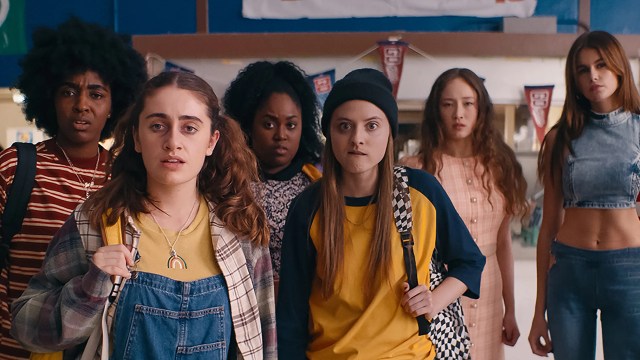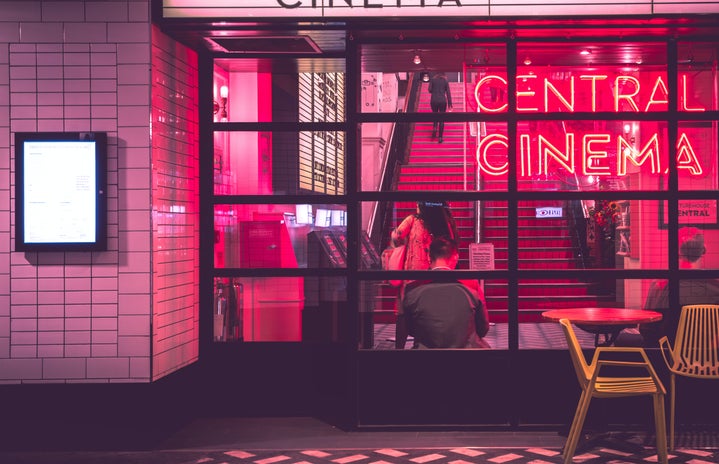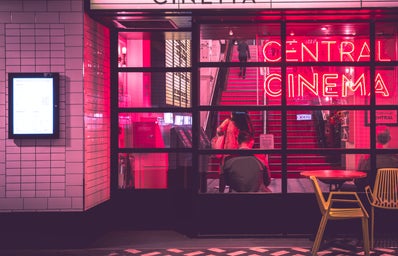Spoilers ahead
Bottoms, directed by Emma Seligman, is a satirical teenage sex comedy set in a suburban high school. PJ (co-writer Rachel Sennott) and Josie (Ayo Edebiri) are unpopular lesbian best friends at Rockbridge Falls High School who have goals of hooking up with two popular cheerleaders that they harbor crushes on: Brittany (Kaia Gerber) and Isabel (Havana Rose Liu), who is dating the star football player, Jeff (Nicholas Galitzine). To achieve this, the two leads decide to start an all-girl fight club under the guise of promoting female solidarity and teaching female students to defend themselves. They take advantage of the very real fear amongst students after an announcement from a female student that she had been assaulted by a member of the rival football team, which Rockbridge Falls’ football team have been preparing to defeat for 20 years.

The premise of high school ‘losers’ going through trials and tribulations to get laid is a familiar storyline that has been done numerous times, but rarely starring queer female characters. It is refreshing to see an LGBTQ+ film that does not focus on exploring one’s queer identity or with a tragic ending, but instead depicts multi-faceted characters that just happen to also be lesbians.PJ and Josie are out and confident in their sexual orientation and are not unpopular because they are gay, but because they are “ugly and untalented”. They are also flawed, selfish characters, willing to lie and exploit the trust other women have placed in them to achieve a self-serving goal, which achieves Seligman’s goal of representing “teen queer characters that have sex drives and are horny and flawed and not just these innocent beings that are either being traumatised or having the most sweet, PG love story” . Edebiri and Sennott effectively portray morally grey yet endearing characters, especially through their awkward mannerisms and on-screen chemistry that has the audience rooting for them despite their poor decisions.
Setting the film in a surreal and exaggerated depiction of high school through scenes such as the student in a cage at the back of the classroom going unexplained, teachers doing anything aside from actually teaching and the bell ringing a minute after students have sat down for class, adds to the hilarity of the ludicrous plotline. It not only pokes fun at comedic tropes but also highlights the fundamental absurdity of misogynistic behaviour and toxic masculinity in general. At first, this behaviour is ridiculed through posters in hallways encouraging girls to smile more and the students’ and teachers’ obsession with a high school football game they have been waiting 20 years for.
However, this heightened reality is also used to emphasise the darker, more serious scenes in the midst of a film jam-packed with jokes and hilarious moments. For example, in an attempt to facilitate group bonding, PJ asks the members of the fight club, “Who’s been raped? Raise your hand! Gray-area stuff counts too.” Sennott’s nonchalant delivery of this line, along with the long shot that shows everyone raising their hand, is chilling. It demonstrates the fundamentally absurd reality of how most women experience some form of sexual harassment at some point in their lives. Contrasting the violence in the fight club enclosed in the safety of the gym with the actual violence they face or fear facing in the outside world is key to expressing how the club has genuinely begun to be a support system for many of the members. This scene is also used to poke fun at some of the ways feminism and female solidarity is being discussed today, where people use buzzwords but are not always sure what they are meant to mean. For example, Hazel (Ruby Cruz), a member of the club, suggests that PJ and Josie should encourage the members to use the club as a “safe space”, which PJ interprets as bluntly asking the members to share their deepest traumas.
Another notable scene is when Hazel is tricked into fighting Tucker, the school’s number one boxer in the football team’s ploy to bring down the fight club as it was diverting attention away from their upcoming game. Tim (Miles Fowler), Jeff’s sidekick, excuses the obvious disparity in strength and size between the two characters by saying that “Girls can do anything that guys can do, right?” This is perhaps a reference to the somewhat common argument made in discussions of gender equality that if men and women are truly equal, it is morally acceptable for men to hit women back. Despite the fight being set up by the football team to publicly humiliate and severely injure Hazel, and by doing so, the fight club as a whole, Tim directs the blame onto Josie and PJ for lying about their motivations for starting the club and their fighting experience, asking “What is wrong with you?…We were really rooting for you girls,” whilst Tucker quite literally kicks Hazel while she’s down. By placing such a poignant scene in this surreal landscape, Seligman and Sennott criticize how women are often victim-blamed for men’s actions towards them in real life.
The fact it is unclear when the film is set adds to the absurdist reality of this suburban high school and allows different generations of people, particularly queer people, to connect to this story. Different characters’ outfits are inspired by trends ranging from the ‘50s to the ‘00s and there is a lack of modern technology in the film, with the occasional flip phone and CD Walkman being used. References to other teen comedies are made throughout the film from different decades, providing viewers with a sense of nostalgia. For example: Isabel’s argyle yellow cardigan and pink fluffy pen, along with Brittany’s yellow plaid tank pay homage to the ‘90s film Clueless, whilst Seligman wanted Rockbridge Falls to have an ‘80s look similar to the school in Ferris Bueller’s Day Off. In an interview with the Guardian, Seligman says that part of the reason for this is she “wanted to put queer characters into all the different decades of teen movies that we missed out on seeing ourselves in.”
Along with Seligman and Sennott’s vivid storytelling, costume designer Eunice Jera Lee’s work in the film deserves appreciation. Josie and PJ dress in earthy tones throughout the movie, which is juxtaposed against the bright colour palette of varsity reds and blues in the school to illustrate that they are the social outcasts of the school. When PJ and Josie host their first fight club meeting, however, they are dressed in red and blue, respectively, perhaps indicating their desire to move up the social ladder. It is also interesting to note that while Josie has a consistent style throughout the movie, mostly wearing oversized tees, PJ is described by Lee as a ‘chameleon’, her outfit in the opening scene reminiscent of The Craft and later outfits mirroring Josie’s style and sometimes Brittany’s. She appears to be less grounded in her identity and seems to change her outfits depending on who she wants to impress or fit in with, which is an act a lot of teenagers can definitely relate to. The other characters in the fight club have their own distinctive styles, emphasizing the mismatch of personalities that have joined together and the unlikely friendships that have arisen as a result. Their individuality is contrasted against the football team only being seen in their football uniforms, mocking the chauvinism in the town and suggests that the toxic masculine ideal reduces men to just their strength and superiority, rather than fully fleshed out characters.
Overall, Bottoms is a hilarious story about teenage lesbians in high school that queer people have been asking for for years: with a flawed but captivating cast, familiar and beloved tropes in teen comedy and a happy ending. Remarkably, it manages to draw attention to problems in modern-day society in a way that is not insensitive yet does not ruin the overall upbeat tone of the film.
Bottoms is out in UK cinemas now.

